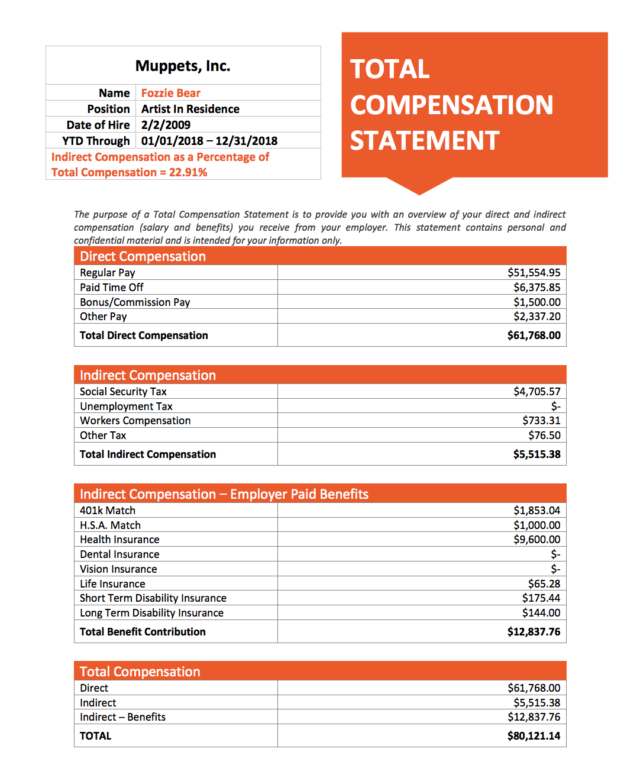In today’s competitive job market, organizations are constantly seeking innovative ways to attract and retain top talent. One such strategy that has gained prominence is the utilization of Employee Benefit Statement Samples. These documents serve as powerful tools for both employers and employees, offering a clear overview of the valuable benefits provided by the company.
Understanding Employee Benefit Statement Samples
Employee Benefit Statement Samples, also known as Total Compensation Statements, are detailed summaries of the benefits and perks offered to employees beyond their salary. These statements go beyond the traditional paycheck to showcase the full spectrum of compensation, including healthcare benefits, retirement plans, paid time off, bonuses, and more.
Why Employee Benefit Statements Matter
For employers, providing Employee Benefit Statements demonstrates transparency and reinforces the value of the compensation package. It helps in fostering a positive company culture, boosting employee morale, and increasing overall satisfaction and retention rates.
On the other hand, for employees, these statements offer valuable insights into the total value of their compensation package. Many employees may not fully realize the extent of the benefits they receive, and Employee Benefit Statements serve as a reminder of the comprehensive support provided by their employer.
Components of an Effective Employee Benefit Statement
- Clear Presentation: Employee Benefit Statements should be well-organized and easy to read. Utilize simple language and visual elements to convey information effectively.
- Comprehensive Benefits Overview: Include all relevant benefits such as healthcare, dental, vision, retirement plans, life insurance, disability coverage, wellness programs, and any additional perks offered by the company.
- Monetary Value: Quantify the value of each benefit whenever possible. Whether it’s the cost of healthcare coverage or employer contributions to retirement plans, providing tangible figures adds credibility to the statement.
- Personalization: Tailor the statement to each individual employee whenever feasible. Highlight specific benefits that are relevant to their needs and preferences, demonstrating a personalized approach to compensation.
- Educational Resources: Offer additional resources or FAQs to help employees better understand their benefits and make informed decisions regarding their compensation package.

Tips for Crafting Effective Employee Benefit Statements
- Be Transparent: Ensure that the information presented is accurate and up-to-date. Transparency builds trust and strengthens the employer-employee relationship.
- Highlight Unique Benefits: If your company offers distinctive perks or benefits, don’t hesitate to showcase them prominently in the statement. These can serve as valuable differentiators in the competitive job market.
- Seek Feedback: Encourage employees to provide feedback on the Employee Benefit Statements. Use this input to continually refine and improve the content and format of the statements.
- Utilize Technology: Leverage digital platforms or software solutions to streamline the creation and distribution of Employee Benefit Statements. This not only saves time and resources but also enhances accessibility for employees.
Implementing Employee Benefit Statements
Once you’ve crafted compelling Employee Benefit Statements, it’s essential to implement a strategy for distribution and utilization. Here are some key steps to consider:
- Distribution Channels: Determine the most effective channels for disseminating Employee Benefit Statements. This could include email, employee portals, printed copies, or presentations during company meetings or orientations.
- Timing: Consider the timing of distributing Employee Benefit Statements. Some organizations choose to provide them annually during performance reviews or as part of the onboarding process for new hires. Others may opt for quarterly or semi-annual updates to keep employees informed.
- Accessibility: Ensure that Employee Benefit Statements are easily accessible to all employees, including remote workers or those without regular access to company computers. Consider providing printed copies or alternative formats for employees with specific accessibility needs.
- Educational Sessions: Host informational sessions or workshops to help employees understand their benefits and how to maximize their value. This can include topics such as retirement planning, healthcare options, and flexible spending accounts.
- Feedback Mechanism: Establish a feedback mechanism for employees to provide input on the content and format of Employee Benefit Statements. This can help identify areas for improvement and ensure that the statements remain relevant and informative.
Measuring Impact
To gauge the effectiveness of Employee Benefit Statements, consider implementing metrics to track engagement and outcomes. This could include:
- Survey Feedback: Conduct surveys or feedback sessions to gather insights from employees regarding their perception of the statements and how they influence their understanding of their benefits.
- Utilization Rates: Monitor the usage rates of various benefits and perks highlighted in the statements. An increase in utilization may indicate that employees are more informed and engaged with their benefits.
- Retention and Satisfaction: Track employee retention rates and satisfaction scores over time to assess the impact of Employee Benefit Statements on overall employee engagement and loyalty.
- Cost Savings: Analyze any cost savings or efficiencies achieved as a result of employees making more informed decisions about their benefits, such as opting for preventive healthcare services or maximizing contributions to retirement plans.
By continuously evaluating the impact of Employee Benefit Statements, organizations can refine their approach and ensure that they remain a valuable tool for both employees and employers alike.

Conclusion
Employee Benefit Statement Samples serve as powerful tools for enhancing transparency, communication, and engagement around employee compensation and benefits. By providing a comprehensive overview of the total value of the compensation package, these statements empower employees to make informed decisions and maximize the benefits offered by their employer.
As organizations strive to attract and retain top talent in today’s competitive landscape, Employee Benefit Statements emerge as essential components of a comprehensive employee benefits strategy. By investing in the creation, distribution, and ongoing evaluation of these statements, organizations can demonstrate their commitment to employee well-being and create a positive and supportive work environment for all.
Unlock the full potential of Employee Benefit Statements and elevate your employee experience to new heights.
